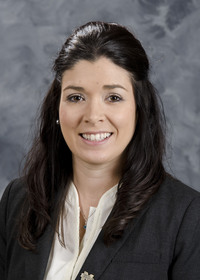Direct Marketing Beef
Freezer Beef
Keeping a few feeder calves on the ranch to produce freezer beef to eat at home or sell to neighbors is very common. Niche markets for custom finished or locally produced beef have existed since the beginning of commercial beef production in the United States. When the market for feeder calves turns down and the cost of beef in the grocery store goes up, beef cattle producers often emphasize custom finishing steers and locally marketing beef, which diversify the beef cattle operation.
Economics
Important factors affect the practicality of direct marketing beef. The first is whether this type of marketing will be profitable. Use a “value of gain” calculation to determine this. The value of gain calculation is similar to the calculations for deciding whether or how long to background feeder calves or graze stockers. First, determine the value of the finished cattle. Then subtract their value as feeder calves. Divide the result by the number of pounds added.
The value of the finished cattle depends on marketing. Consider an example where finished cattle are marketed on live weight. In this example, the live weight price for finishing cattle is $0.97 per pound, and the price for 700-pound stockers is $0.80 per pound. The calculation is as follows: ((1200 pounds x $0.97/pound) – (700 pounds x $0.80/pound)) / 500 pounds = $1.21. In this example, each pound added is worth $1.21.
The next figure required to calculate the real value of gain is “cost of gain.” This will fluctuate with diet cost and cattle feed efficiency. If cost of the finishing diet is $200 per ton (($200/ton) × (1 ton/2000 pounds) = $0.10 per pound) and it takes 6 pounds of feed to produce 1 pound of gain, the feed cost of gain is $0.60 per pound ($0.10 per pound x 6 pounds feed/1 pound gain = $0.60 per pound of gain). The actual cost of gain would also include labor, equipment, and other peripheral costs of animal maintenance.
On-farm finishing of beef cattle limits cash flow from those animals in the short term. If a 700-pound steer is harvested at 1200 pounds and gains an average of 3 pounds per day (500 pounds of gain needed/3 pounds per day gain = 167 days), revenue is offset for 167 days, or about 5½ months. Therefore, include interest in economic calculations. Finally, subtract the cost of gain from the preliminary value of gain to get the actual value of gain, which in this example is $0.61 per pound for 500 pounds, or a total of $305. If the peripheral costs add substantially to the cost of gain, the gain can become a loss.
Selling beef directly to consumers enables beef cattle producers to set prices that cover costs and provide profits if there are enough buyers at these price levels. Many consumers are willing to pay premiums for freezer beef from cattle producers who develop relationships with them and share information about cattle management practices. Prices often fluctuate seasonally in fed cattle markets. Selling freezer beef directly to consumers for a consistent price can even out profits.
Feeding Program
The method for adding pounds also affects the profitability of direct marketing beef. Feeding choices include forage finishing, concentrate (grain-based) finishing, and a mix of those two methods. Deciding which feeding approach to use is not always simple. Evaluate available resources (forage availability and the quality, cost, and nutritional value of commodity feeds), and work with a nutritionist to make this decision.
Consider how cattle diet impacts feed efficiency and how feed efficiency affects cost of gain. Also take into account how the diet will influence beef quality and how that quality will be perceived by the target consumer. Most southeastern U.S. cattle producers include forages to some extent. Consider using ionophores to improve feed efficiency and help control coccidiosis.
To plan a cattle finishing program on the ranch, first decide on the target animal age and live weight at harvest. Use cattle frame size to estimate the ideal weight at harvest to achieve a given level of back fat thickness in the fed cattle. For example, large-frame steers are expected to grade Choice at 1250 pounds or higher, whereas large-frame heifers are expected to grade Choice at 1150 pounds or more. Medium-frame steers are expected to grade Choice at 1100, and medium-frame heifers are expected to do so at 1000 pounds. Small-frame steers are expected to grade Choice at less than 1100 pounds, and small-frame heifers are expected to grade Choice at less than 1000 pounds. Based on the expected animal age and weight at the start of the finishing phase, set a target harvest date.
Calculate the rate of weight gain needed during cattle finishing to meet target weights by the harvest date. Determine if this rate of weight gain is achievable and cost-effective for the production circumstances. When estimating expected rates of gain on different nutritional regimes, consider the genetic potential of the cattle. Once the finishing program is underway, monitor cattle weight gains periodically and adjust the nutritional program to meet target finishing goals.
Forage finishing requires high-quality forages to achieve acceptable rates of gain and finished weights in a reasonable time frame. Calving seasons, weaning dates, and seasonal forage growth patterns affect forage finishing. Match forage species and availability to cattle nutrient needs to develop lean muscle and fat. Efficient forage finishing systems for beef cattle require planning. Economics; consumer preference for fat color; and feed availability, nutrient value, and price may dictate the degree to which forages are used for cattle finishing.
Processing Considerations
Good communication between beef cattle producers and processors is essential. Visit with processors well in advance of cattle harvests to learn processing schedules, beef cut options, meat packing alternatives, and processing costs. Ask how much advance notice the processor needs. Ask about any processor specifications regarding age, weight, and daily number of head of cattle that can be processed at the facility. Make sure that the processor has enough freezer space available for the amount of beef to be harvested and stored over a given time period. Inquire about cost of frozen storage, if any.
Be sure all cattle delivered to the harvesting facility arrive clean, clearly identified, and on time. It may be more cost-effective to deliver as many head of cattle on each load as possible within processor limits. Maximizing the number sent at one time spreads freight cost across more head of cattle, which is especially important when hauling cattle long distances to harvest. It may also lessen processing costs.
The Niche Meat Processor Assistance Network is a group supported by the Cooperative State Research, Education, and Extension Services of the U.S. Department of Agriculture. Their goal is to “strengthen and expand processing capacity, nationwide, for niche meats.” They publish information on locating local processors and understanding beef processing and sale regulations.
Beef Marketing Considerations
The effort needed for marketing the final beef product is one of the most common reasons that some beef cattle producers do not do direct sales. If cattle have remained on the farm of origin, source verification is possible, which can attract some consumers. Advertising the product as not having been treated with antibiotics can attract some consumers who might be willing to pay more for it. Maintain accurate records, and market the individual animals that did not require medication as “not antibiotic treated.” This marketing strategy can also apply to cattle that did not receive growth-promoting implants or medicated feed. Beef from cattle finished on forage-based systems can also find a niche market.
Make sure to communicate effectively with consumers regarding the product if cattle for harvest received any animal health products or growth-promoting additives, clearly explain this to customers to avoid any misunderstandings. It may also be helpful to provide customers with an overview of what the cattle were fed and how they were managed.
Any increase in market price from these management strategies might not offset reduced performance caused by the lack of antibiotics, growth-promoting implants, or ionophores. Refer to Mississippi State University Extension Publications 2485 Growth-Promoting Implants for Beef Cattle and 2518 Feed Additives for Beef Cattle for more information on the benefits of using growth-promoting implants or ionophores. When marketing, do not imply that other beef products are any less healthy or wholesome. Such statements could damage the beef industry as a whole. The consumer’s willingness to pay more for these management practices decreases as the general economy slumps. Constantly question whether there will be any real value to each added practice.
Finding a processor can sometimes be a challenge. Any meat product intended for retail sale must be harvested in a U.S. Department of Agriculture-inspected facility. Inspected custom processors are not as common as they once were and might be far from the ranch, making freight costs a limiting factor. To overcome this challenge, market the live animal to the consumer and offer to haul it to a custom processor that will package the beef to the buyer’s specifications. The consumer typically pays the cattle producer for the live animal based on a carcass weight price and pays the processor directly for animal harvest, beef processing, and beef packaging.
The sheer size of a whole beef carcass and consumer demand for individual cuts make direct beef marketing challenging. Customer service is extremely important in direct beef sales. Take time to explain to consumers how much beef they can expect, the processor options for different meat cuts and packaging, and the cost of processing.
Freezer beef is often priced based on hot carcass weight, so it is important that consumers understand how much carcass weight to expect. Finished beef carcass weights often weigh between 550 and 950 pounds but can vary widely depending on cattle genetics and management. Cutting and trimming procedures influence the percent retail yield. Removing fat and bone decreases the percent retail yield. Table 1 shows the approximate retail yields from carcasses of different Yield Grades. Detailed explanations of animal live weights, hot carcass weights, dressing percentages, beef Yield Grades, and beef Quality Grades appear in Mississippi State University Extension Service Publication 2522 Beef Grades and Carcass Information.
|
Yield Grade |
Forequarter, % retail yield |
Hindquarter, % retail yield |
|---|---|---|
|
1 |
84.0 |
79.9 |
|
2 |
79.0 |
74.9 |
|
3 |
75.6 |
69.9 |
|
4 |
71.4 |
64.9 |
|
5 |
67.2 |
59.9 |
Some consumers may want a half (a side) or quarter (forequarter or hindquarter) of a beef carcass instead of a whole beef carcass, so coordinate cattle harvests based on consumer demands. A forequarter includes the chuck, rib, brisket, plate, and full flank. It generally has fewer tender cuts and more cuts that require pot roasting. However, a forequarter provides a higher percentage of usable lean meat and costs less than the side or carcass. A hindquarter includes the round, loin, and the flank. It provides more steaks and roasts but costs more per pound than a side or carcass.
Explain to consumers that a whole carcass or a side contains a variety of high- and low-priced cuts. A beef carcass generally consists of about 25 percent waste, 25 percent ground beef and stew meat, 25 percent steaks, and 25 percent roasts. For example, a Yield Grade 3 carcass weighing 700 pounds with 25 percent waste has about 525 pounds of usable meat. Each side of beef (carcass half) would therefore contain about 262.5 pounds of usable beef.
Tell consumers how much freezer space will be needed to store the meat. As a rule of thumb, one cubic foot of freezer space stores approximately 35 to 40 pounds of cut and wrapped meat. Oddly shaped meat takes up slightly more space.
Help consumers understand when to expect the final product by explaining harvest dates and meat processing and storage times. Before harvest, ask each customer detailed questions to be sure that processing directions meet their needs. For example, ask consumers how much hamburger they prefer per package, how thick they prefer their steak cuts, and how long they want their meat to age. Make sure consumers understand the importance of paying for processing and picking up beef promptly from processors.
Good communication with beef customers is critical in direct marketing beef. Listen to what they want and adjust cattle production practices when appropriate. Give written information about what to expect from a freezer beef purchase to buyers, particularly first-time buyers. Follow up with consumers who suddenly stop purchasing freezer beef to find out why they stopped. Develop an order form that makes the beef purchase clear to both the producer and consumer. Some producers request a deposit from new customers before cattle finishing to safeguard against incurring cattle finishing costs and then having no buyer for the end product.
Word of mouth is a common means to advertise direct beef sales. Thus, developing and maintaining a good reputation as a freezer beef producer is crucial to future sales. Ranch websites and advertisements in industry publications are other methods of reaching the customer base. Mississippi MarketMaker is one website that provides an interactive mapping system for locating businesses and markets of agricultural products in Mississippi and links between producers and consumers. Direct beef marketing can expand beyond the local area using these types of marketing tools.
Direct Marketing Beef Conclusions
Much of the large-scale cattle finishing operations are outside the southeast U.S. Grain growing and fed cattle processing facility locations influence this.
Forage-finishing or a mix of forage- and concentrate-based finishing eliminates or reduces reliance on concentrate-based feeds. High-quality forage systems are possible throughout Mississippi but require proper planning and management.
Maintain some flexibility with regard to cattle diet, length of feeding phase, and volume. If the feeder calf market is relatively high and cost of retail beef declines, then custom finishing on a small scale may not be profitable. Retaining a few calves each year to market as finished live cattle for freezer beef can help diversify a cow-calf or stocker operation and could increase profit. For more information on beef marketing or related topics, contact an office of the Mississippi State University Extension Service.
References
Mississippi MarketMaker. 2009. Accessed May 11, 2009.
NMPAN. 2009. Niche Meat Processor Assistance Network. Accessed May 11, 2009.
Publication 2563 (POD-09-23)
The Mississippi State University Extension Service is working to ensure all web content is accessible to all users. If you need assistance accessing any of our content, please email the webteam or call 662-325-2262.





